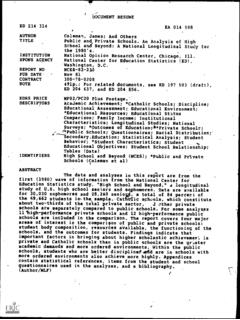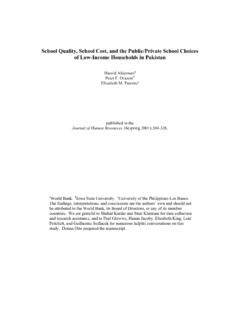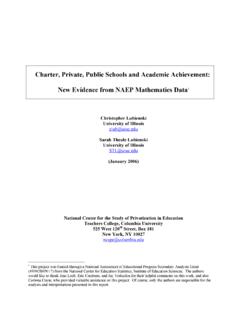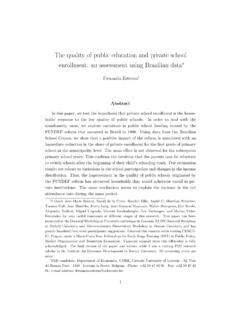Transcription of Competition Among Schools: Traditional Public and Private ...
1 CHAPTER 4 Competition Among Schools: Traditional Public and Private SchoolsM. UrquiolaColumbia University and NBER, New York, NY, United Simple 1: Do Children Experience Higher Achievement Gains in Private Than in PublicSchools? 2: If Private Schools Raise Achievement More, Is This Because These SchoolsAre More Productive? 3: Does Competition From Private Schools Raise Public school Productivity? Doesthe Existence of Private Schools Otherwise Affect Those Left Behind in Public Schools? 1: Do Children Experience Higher Achievement Gains in Private Than in PublicSchools? 2: If Private Schools Raise Achievement More, Is This Because These SchoolsAre More Productive?
2 3: Does Competition From Private Schools Raise Public school Productivity? Doesthe Existence of Private Schools Otherwise Affect Those Left Behind in Public Schools? From Small-Scale Programs Related to Question 3: Canada, India, and the chapter considers research on the effects of Competition between Private and Public schools. Itfocuses on three questions: (1) Do children experience higher achievement gains in Private school ? (2) Ifso, is this because Private schools are more productive? (3) Does Competition from Private schools raisepublic school productivity and/or otherwise affect those left behind ?
3 The chapter shows that unlesseach of these questions is answered, one cannot form a full assessment on the desirability of privateschool entry. Voucher experiments suggest that question 1 can be answered in the affirmative for somesubgroups and in some contexts. Such work cannot typically isolate channels, however, and hencedoes not address question 2. Question 3 has been primarily studied by papers on large-scale voucherprograms. These suggest that Private school entry results in nonrandom sorting of students, but are lessclear on the effects. The bottom line is that despite demand for clear, simple conclusions on the effectsof Competition from Private schools, research does not yet provide of the Economics of Education, Volume 5 Copyright 2016 Elsevier 1574-0692, rights , Private schools, Sorting, school productivity1.
4 INTRODUCTIONT here is a long-standing perception Among economists (eg,Smith, 1776; Friedman,1955) that Competition can improve school markets performance. Traditionally, com-petition has been envisioned to take the form of entry by Private schools into marketspreviously dominated by Public schools. The conjecture is that such entry can enhancethe accumulation of skill, or at least reduce the cost of its is not surprising that this seems plausible to many observers. After all, in somesettings the counterfactual to a larger Private sector is a Public sector in which it at leastcasually appears difficult to terminate transparently underperforming teachers, reducerampant absenteeism, or introduce meaningful curricular chapter provides an overview of what economic research has revealed andwhat knowledge gaps remain on the effects of Competition between Traditional Public and Private schools.
5 The exact meaning of this label will depend on the setting,but it leaves aside, for example, somewhat more recent institutional forms, such as charterschools in the chapter organizes the issues by focusing on three sets of children experience higher achievement gains in Private than in Public schools? Private schools raise achievement more, is this because these schools are more pro-ductive? (We shall understand a given school to be more productive than another if itproduces more skill given the same resources.) Competition from Private schools raise Public school productivity?
6 Does theexistence of Private schools otherwise affect those left behind in Public schools?The chapter first sets out a simple framework to show that unlesseachof these questionscan be answered, one cannot form a full assessment on the desirability of greater com-petition from Private schools. The discussion emphasizes three further points. First, eco-nomic theory suggests that none of these questions has an answer that is clear a priori; theeffect of Competition on school market performance is therefore an empirical , question 1 can be credibly answered if one has exogenous variation in privateschool attendance as provided, for example, by many voucher experiments.
7 Third, suchexperiments do not typically provide answers to questions 2 and 3; analyses of large-scalevoucher reforms are better suited to tackling these, but face significant methodologicalchallenges related to identification and nonrandom sorting of evidence on charter schools is covered elsewhere in this (2002b)provides a useful introduction to the importance of school productivity in the analysis ofcompetition between schools. Our definition is different than the one she uses, but in the same of the Economics of EducationThe chapter then considers the existing evidence. Rather than attempt to provide anexhaustive survey, it focuses on the research and settings that potentially provide the mostcredible answer to these questions, but which also help frame future avenues , on question 1 the discussion centers mainly on evidence fromthe USA, Colombia, and India.
8 On questions 2 and 3, it focuses on evidence from Chileand preview the findings, the literature has made significant strides in answering ques-tion 1. Randomized experiments show that in some settings students acquire greater skillif they attend Private rather than Public school , although a perhaps surprisingly large pro-portion of estimates suggest an impact that is statistically indistinguishable from type of work has made less progress providing answers to question 2. It doesprovide some evidence consistent with Private schools producing skills at lower financialcost (most instances of this result originate in low-income countries and at the primarylevel; there is little evidence on whether it generalizes beyond that).
9 However, effectivelytackling question 2 requires disentangling all the possiblechannelsthrough which a privateschool effect operates. This is typically not feasible in the contexts of the randomizedwork. This has important implications, since the case for expanding the Private sectoris much stronger if one can make the case that higher achievement in Private schoolsreflects higher productivity. Otherwise it could reflect potentially zero-sum mechanismsrelated to peer effects, for question 3 ideally requires exogenous cross-market variation in the extentof Private enrollment. Not surprisingly experiments to date have not achieved this.
10 As analternative, some research has focused on large-scale voucher reforms that have inducedsubstantial expansions in some countries Private sectors, with variation across analyses have the advantage of potentially revealing the general equilibrium effectsof Competition from Private schools; but they face challenges related to identification, andto the fact that Private entry is frequently associated with nonrandom sorting of studentsacross sectors. A mixed assessment of the effects of Competition also emerges from thiswork. Specifically, while growth in the Private sector seems to have resulted in sortingand stratification, its impact on learning appears more mixed.



















